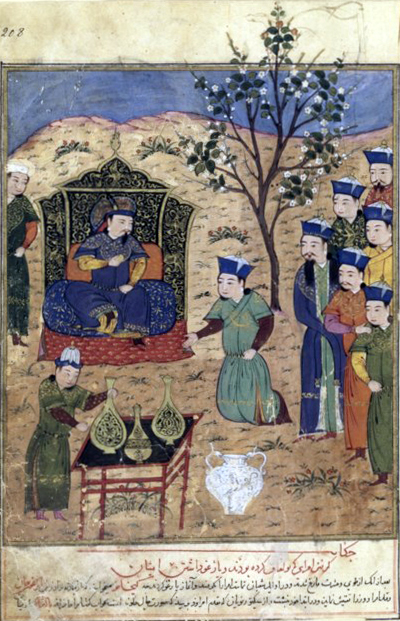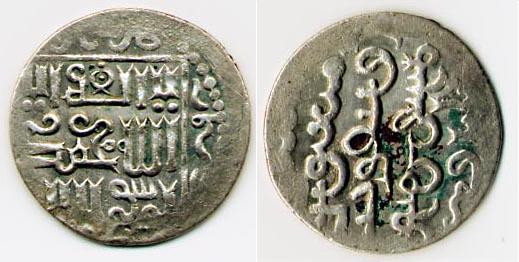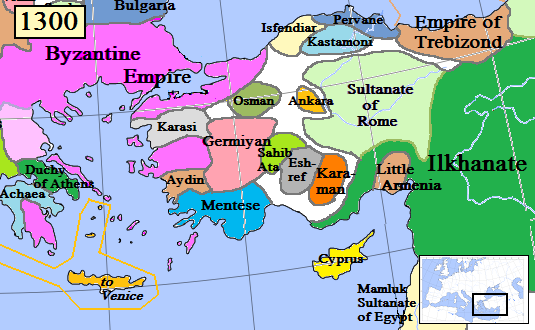|
Gaikhatu
Gaykhatu (Mongolian script:; ) was the fifth Ilkhanate ruler in Iran. He reigned from 1291 to 1295. His Buddhist baghshi gave him the Tibetan name Rinchindorj () which appeared on his paper money. Early life He was born to Abaqa and Nukdan Khatun, a Tatar lady in c.1259. He was living in Jazira during Tekuder's reign and had to flee to Arghun in Khorasan after Qonqurtai's execution in 1284. He was given as hostage to Tekuder by Arghun as a condition of truce in June 1284 and put in orda of Todai Khatun, his step-mother. After Arghun's enthronement, he was confirmed as governor of Anatolia together with his uncle Hulachu. Rule in Anatolia He was stationed in Erzinjan and learnt to speak Persian and to some degree Turkish during his stay in Anatolia. Gaykhatu ruled Anatolia solely after recall of Hulachu to Iran in 1286. It was then he was married to Padishah Khatun, a princess of Qutlugh-Khanids. He aided Masud II on his campaigns against Turkmen principalities, most import ... [...More Info...] [...Related Items...] OR: [Wikipedia] [Google] [Baidu] |
Arghun
Arghun Khan (Mongolian Cyrillic: ''Аргун хан''; Traditional Mongolian: ; c. 1258 – 10 March 1291) was the fourth ruler of the Mongol empire's Ilkhanate, from 1284 to 1291. He was the son of Abaqa Khan, and like his father, was a devout Buddhist (although pro-Christian). He was known for sending several embassies to Europe in an unsuccessful attempt to form a Franco–Mongol alliance against the Muslims in the Holy Land. It was also Arghun who requested a new bride from his great-uncle Kublai Khan. The mission to escort the young Kököchin across Asia to Arghun was reportedly taken by Marco Polo. Arghun died before Kököchin arrived, so she instead married Arghun's son, Ghazan. Early life Arghun was born to Abaqa Khan and his Öngüd, possibly Christian concubine Qaitmish egechi in 8 March 1259 (although Rashid al-Din states it was in 1262, which is unlikely) near Baylaqan. He grew up in Khorasan under care of Sartaq Noyan (from Jalair tribe) who was his militar ... [...More Info...] [...Related Items...] OR: [Wikipedia] [Google] [Baidu] |
Baydu
Baydu (Mongolian script:; ) (died 1295) was the sixth ruler of the Mongol empire's Ilkhanate division in Iran. He was the son of Taraqai, who was in turn the fifth son of Hulagu Khan.Stevens, John. ''The history of Persia. Containing, the lives and memorable actions of its kings from the first erecting of that monarchy to this time; an exact Description of all its Dominions; a curious Account of India, China, Tartary, Kermon, Arabia, Nixabur, and the Islands of Ceylon and Timor; as also of all Cities occasionally mention'd, as Schiras, Samarkand, Bokara, &c. Manners and Customs of those People, Persian Worshippers of Fire; Plants, Beasts, Product, and Trade. With many instructive and pleasant digressions, being remarkable Stories or Passages, occasionally occurring, as Strange Burials; Burning of the Dead; Liquors of several Countries; Hunting; Fishing; Practice of Physick; famous Physicians in the East; Actions of Tamerlan, &c. To which is added, an abridgment of the lives of the ki ... [...More Info...] [...Related Items...] OR: [Wikipedia] [Google] [Baidu] |
Ilkhan (title)
Il Khan (also ''il-khan'', ''ilkhan'', ''elkhan'', etc.), in Turkic languages and Mongolian, is a title of leadership. It combines the title ''khan'' with the prefix ''el/il'', from the word ''ulus'' – 'tribe, clan', 'the people', 'nation', 'homeland', 'state', 'tribal union', etc. Meaning The exact meaning depends on context: *Khan of the nation. The earliest mention of a similar title in this meaning, namely "Illig Qaghan", refers to Bumin Qaghan and dates to 552 CE. (In fact, Nikolai Gumilyov transcribes Bumin's title as "ilkhan".) *More recently, the tribal chief that heads both branches of the Bakhtiari people, under whom several ''khans'' operate (20th century CE). In the context of the Hulaguid dynasty, commonly known as the Ilkhanate, the title ''Ilkhan'' was borne by the descendants of Hulagu and later other Borjigin princes in Persia, starting from c. 1259-1265. Two interpretations have been proposed: *'submissive', 'peaceable', 'obedient', or 'subservient' khan, or ... [...More Info...] [...Related Items...] OR: [Wikipedia] [Google] [Baidu] |
Tarsus, Mersin
Tarsus (Hittite language, Hittite: 𒋫𒅈𒊭 ; grc, Ταρσός, label=Ancient Greek, Greek ; xcl, Տարսոն, label=Old Armenian, Armenian ; ar, طَرسُوس ) is a historic city in south-central Turkey, inland from the Mediterranean Sea, Mediterranean. It is part of the Adana-Mersin metropolitan area, the fourth-largest metropolitan area in Turkey with a population of 3 million people. Tarsus forms an administrative district in the eastern part of Mersin Province, Mersin province and lies at the heart of the region. With a history going back over 6,000 years, Tarsus has long been an important stop for traders and a focal point of many civilisations. During the Roman Empire, it was the capital of the province of Cilicia (Roman province), Cilicia. It was the scene of the first meeting between Mark Antony and Cleopatra, and the birthplace of Paul the Apostle, St Paul the Apostle. Tarsus is home to one of Turkey's most famous high schools, the Tarsus American College ... [...More Info...] [...Related Items...] OR: [Wikipedia] [Google] [Baidu] |
Güneri Of Karaman
Güneri of Karaman was the third bey of Karaman Beylik, a Turkish principality in Anatolia in the 13th century. His father was Karaman Bey. After his elder brother Mehmet I was executed by the Mongols in 1277, he became the leader of the beylik. Early years of his reign were eventless. But in 1284 he took advantage of the civil war in Seljuk lands and he supported two infants for the Seljuk throne (not much different from the policy of Mehmet I.) In turn, he was declared a beylerbey of Seljuks. But upon the intervention of Arghun (Mongol khan) he had to recede to his own territory to the south of Seljuk lands. In 1287 he attacked Tarsus, then a part of the Armenian Kingdom of Cilicia. However Seljuks and Mongols who supported Leon II of Armenia invaded his territory, burned his capital Karaman and forced him to recede once more. Next year he accepted the suzerainty of Seljuks. In 1294, he recaptured Alaiye an important port on the Mediterranean Sea which was recently captured ... [...More Info...] [...Related Items...] OR: [Wikipedia] [Google] [Baidu] |
Leo II, King Of Armenia
Leo II or Leon II (occasionally numbered Leo III; , ''Levon II''; c. 1236 – 1289) was king of the Armenian Kingdom of Cilicia, ruling from 1269''Cambridge Medieval History'', Volume IV, p. 634/1270 to 1289. He was the son of King Hetoum I and Queen Isabella and was a member of the Hetoumid family. Early life Leo was born in 1236, the son of King Hetoum I and Queen Isabella. Hetoum and Isabella's marriage in 1226 had been a forced one by Hetoum's father Constantine of Baberon, who had arranged for Queen Isabella's first husband to be murdered so as to put Constantine's own son Hetoum in place as a co-ruler with Isabella. They had six children, of which Leo was the eldest. One of his sisters was Sibylla of Armenia, who was married to Bohemond VI of Antioch to bring peace between Armenia and Antioch. In 1262, Leo married Keran (Kir Anna), the daughter of Prince Hetoum of Lampron. In 1266, while their father king Hetoum I was away to visit the Mongol court, Leo and his yo ... [...More Info...] [...Related Items...] OR: [Wikipedia] [Google] [Baidu] |
Armenian Kingdom Of Cilicia
The Armenian Kingdom of Cilicia (Middle Armenian: , '), also known as Cilician Armenia ( hy, Կիլիկեան Հայաստան, '), Lesser Armenia, Little Armenia or New Armenia, and formerly known as the Armenian Principality of Cilicia ( hy, Կիլիկիայի հայկական իշխանութիւն), was an Armenians, Armenian state formed during the High Middle Ages by Armenian refugees fleeing the Seljuk Empire, Seljuk invasion of Armenia., pp. 630–631. Located outside the Armenian Highlands and distinct from the Kingdom of Armenia (antiquity), Kingdom of Armenia of classical antiquity, antiquity, it was centered in the Cilicia region northwest of the Gulf of Alexandretta. The kingdom had its origins in the principality founded c. 1080 by the Rubenid dynasty, an alleged offshoot of the larger Bagratuni dynasty, which at various times had held the throne of Armenia. Their capital was originally at Tarsus (city), Tarsus, and later became Sis (ancient city), Sis. Cilicia wa ... [...More Info...] [...Related Items...] OR: [Wikipedia] [Google] [Baidu] |
Karamanids
The Karamanids ( tr, Karamanoğulları or ), also known as the Emirate of Karaman and Beylik of Karaman ( tr, Karamanoğulları Beyliği), was one of the Anatolian beyliks, centered in South-Central Anatolia around the present-day Karaman Province. From the middle 1300s until its fall in 1487, the Karamanid dynasty was one of the most powerful beyliks in Anatolia. History The Karamanids traced their ancestry from Hodja Sad al-Din and his son Nure Sofi, Nure Sufi Bey, who emigrated from Arran (Caucasus), Arran (roughly encompassing modern-day Azerbaijan) to Sivas because of The Mongol Invasions, the Mongol invasion in 1230. The Karamanids were members of the Salur tribe of Oghuz Turks. According to Muhsin Yazıcıoğlu and others, they were members of the Afshar tribe,Cahen, Claude, ''Pre-Ottoman Turkey: A General Survey of the Material and Spiritual Culture and History c. 1071–1330'', trans. J. Jones-Williams (New York: Taplinger, 1968), pp. 281–2. which participated in t ... [...More Info...] [...Related Items...] OR: [Wikipedia] [Google] [Baidu] |
Mesud II
Ghiyath al-Dīn Me’sud ibn Kaykaus or Mesud II ( 1ca, مَسعود دوم, ''Ghiyāth ad-Dīn Mas'ūd bin Kaykāwūs'' ( fa, غياث الدين مسعود بن كيكاوس) bore the title of Sultan of Rûm at various times between 1284 and 1308. He was a vassal of the Mongols under Mahmud Ghazan and exercised no real authority. History does not record his ultimate fate. He was the last of the Seljuks. Reign Masud II was the eldest son of Kaykaus II. He spent part of his youth as an exile in the Crimea and lived for a time in Constantinople, then the capital of the Byzantine Empire. He appears first in Anatolia in 1280 as a pretender to the throne. In 1284 the new Ilkhan Sultan Ahmed deposed and executed the Seljuq sultan Kaykhusraw III and installed Masud in his place. Ahmad's successor, Arghun, divided the Seljuq lands and granted Konya and the western half of the kingdom to the deposed sultan's two young sons. Masud invaded with a small force, had the two boys killed, and ... [...More Info...] [...Related Items...] OR: [Wikipedia] [Google] [Baidu] |
Qutlugh-Khanids
The Qutlugh-Khanids (otherwise known as the Qutlugh-Khanid dynasty, Kirmanid dynasty, or very rarely as the Later Western Liao) was a dynasty of ethnic Khitan origin that ruled over Kirman (in present-day Kerman Province, Iran) from 1222 to 1306. It was founded by Buraq Hajib, who emigrated from the Qara Khitai (Western Liao dynasty) during the collapse of the realm. Originally an independent entity, the Qutlugh-Khanid dynasty subsequently ruled as vassals of the Khwarazmian dynasty, the Mongol Empire and the Ilkhanate. The dynasty was removed from power by the Ilkhanid ruler Öljaitü, who appointed Nasir al-Din Muhammad ibn Burhan as governor of Kirman. Later Western Liao Although there was no mention of a dynasty called the "Later Western Liao" (后西辽) in traditional Chinese scholarship, Wang Zhilai wrote a paper ''On the Later Western Liao'' (关于"后西辽") in 1983, where he proposed to call the Qutlugh-Khanids the "Later Western Liao", thereby positioning the dyn ... [...More Info...] [...Related Items...] OR: [Wikipedia] [Google] [Baidu] |
Turkish Language
Turkish ( , ), also referred to as Turkish of Turkey (''Türkiye Türkçesi''), is the most widely spoken of the Turkic languages, with around 80 to 90 million speakers. It is the national language of Turkey and Northern Cyprus. Significant smaller groups of Turkish speakers also exist in Iraq, Syria, Germany, Austria, Bulgaria, North Macedonia, Greece, the Caucasus, and other parts of Europe and Central Asia. Cyprus has requested the European Union to add Turkish as an official language, even though Turkey is not a member state. Turkish is the 13th most spoken language in the world. To the west, the influence of Ottoman Turkish—the variety of the Turkish language that was used as the administrative and literary language of the Ottoman Empire—spread as the Ottoman Empire expanded. In 1928, as one of Atatürk's Reforms in the early years of the Republic of Turkey, the Ottoman Turkish alphabet was replaced with a Latin alphabet. The distinctive characteristics of the Turk ... [...More Info...] [...Related Items...] OR: [Wikipedia] [Google] [Baidu] |
Persian Language
Persian (), also known by its endonym Farsi (, ', ), is a Western Iranian language belonging to the Iranian branch of the Indo-Iranian subdivision of the Indo-European languages. Persian is a pluricentric language predominantly spoken and used officially within Iran, Afghanistan, and Tajikistan in three mutually intelligible standard varieties, namely Iranian Persian (officially known as ''Persian''), Dari Persian (officially known as ''Dari'' since 1964) and Tajiki Persian (officially known as ''Tajik'' since 1999).Siddikzoda, S. "Tajik Language: Farsi or not Farsi?" in ''Media Insight Central Asia #27'', August 2002. It is also spoken natively in the Tajik variety by a significant population within Uzbekistan, as well as within other regions with a Persianate history in the cultural sphere of Greater Iran. It is written officially within Iran and Afghanistan in the Persian alphabet, a derivation of the Arabic script, and within Tajikistan in the Tajik alphabet, a der ... [...More Info...] [...Related Items...] OR: [Wikipedia] [Google] [Baidu] |



.jpg)



